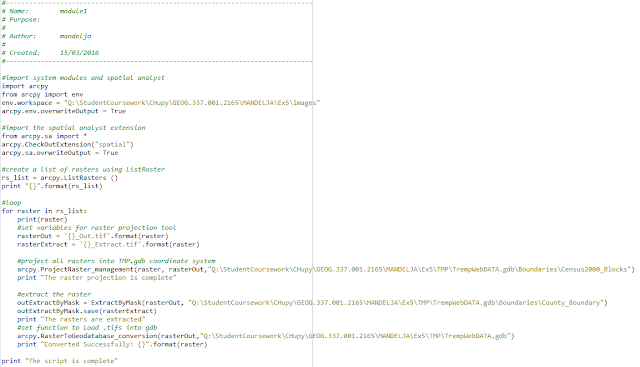Network Analyst with Frac Sand Mines
Introduction:
The goal of this exercise is to run network analysis of the roads used to connect frac mines to rail terminals. Routing using the analyst will be done to determine which roads are used by how many mines, this will allow a damage estimate for the roads to be given as well as a cost for maintenance. To measure the impact and cost on the county roads the following workflow was used:
1) Determine what terminal the sand from each mine will go to to be put on a rail car
2) Determine the most efficient route to each terminal
3) Calculate the length of the route by county
4) Estimate the costs for each county for road maintenance
Additional background for how this process would be run was gathered from reading sections of "Transportation Impacts of Frac Sand Mining in the MAFC Region: Chippewa County Case Study" published by the National Center for Freight and Infrastructure Research and Education.
Methods:
The first step in this project was running a python script to prepare the multiple layers of data to go into network analyst. The script ran on all of the mines in the data set to come up with the mines that were desired. These mines had to fit the criteria of being an active mine, not having a rail loading station, and they had to be farther than 1.5 km from a rail line. The script had to be written to account for the multitude of variables within the geodatabase, a screenshot of the script is below as figure 1.
Figure 1: This python script was run to determine which mines throughout the whole state fit the desired criteria.
The next step in the project was to determine which of the mines, found using the python script, would be routed to which rail terminal for distribution and processing. Instead of running a long list of tools within arcmap, model builder was utilized to use network analyst to find the shortest routes for the trucks. Once that was found calculations were done within the fields of data to determine the mileage each road would see as a result of routing and a simple formula of 2.2 cents per mile was used to calculate road repair and maintenance cost from the high use by sand trucks. The workflow in model builder is figure 2 showing how many steps, additions, and tools this process required.
Figure 2: The workflow created in model builder to answer the research question.
Results:
The "Closest Facility" function run in the model builder created the information output to go into the display of figure 3, a map of the best routes for each facility to send its trucks on to get to a terminal.
Figure 3: This map displays the best routes for frac sand trucks to take to rail terminals.
The next step was to determine the cost of each truck route in each county. This would show how much money it is going to cost the county to have upkeep on the road each year. This was done by using the "length" field to calculate from meters to miles then, assuming each truck does 100 trips a year, multiplying the miles by 100. That final miles measurement is then multiplied by $.22 for each mile the truck travels. The resulting table of figures can be seen in figure 4 and the map of those figures displaying the cost is in figure 5.
Figure 4: This is a screenshot of the attribute table of the calculations done in model builder.
Figure 5: This map displays, by counties relevant to the study, how much road maintenance will cost in US dollars.
Conclusion/Discussion:
The final answer is displayed by figure 6, a graph of the costs per county, and is displayed by figure 5. The cost of running and routing frac sand in trucks on county roads ads a considerable cost to a budget that must be accounted for. Of course this cost analysis doesn't account for environmental long term cost but it does give an idea on some level of the impact on roads. If this project were done again it would be interesting to see how much the counties budgeted for road repair and how much of that budget was going to repair frac mine frequented roads. This could also be calculated in model builder.
Figure 6: This graph compares each county's cost to the other county's cost for road maintenance on the routes within the county.
This project used a combination of python and model builder to create outputs to answer a spatial question. Though initially difficult to work with the python and model builder offers an efficient and visible way to work the data instead of running it all by tools. This was a great way to get more acquainted with each form of software to run arcmap and I am certainly more comfortable with it at this point. It was helpful to see how such a complex question could be answered without running endless tools by hand. The focus, network analyst, seemed to me to very similar to how google maps routes and in many ways it is. This is such a complex service that understanding how it works on this level is fascinating and offers a lot of insight into how GIS and network analyst specifically can be practically applied to so many of today's issues.
Sources:
Hart, Maria, Teresa Adams, and Adrew Schwartz. "Transportation Impacts of Frac Sand Mining Ie MAC Region: Chippewa County Case Study." National Center for Freight & Infrastructure Research & Education (2013). Web. 16 Apr. 2016.

















